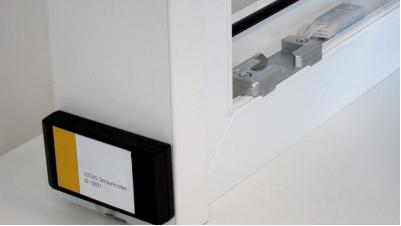If you have a home alarm security system, or merely observed one at a neighbor’s house or watched one being installed, it’s likely that you’ve wondered why all of those sensors attached to the windows are wired. Good question.
As the owner of a security system, I always wondered why there was such a reliance on a physical media that could be defeated with a simple snip. And while my primary concern was always about the connection of my house to the monitoring service, the wired windows gave me pause as well.
Given the preponderance of wireless technologies that have been around for some time one would have thought that in the year 2012 there would be a wireless solution on the market. The good news coming from Researchers at the Fraunhofer Institute for Integrated Circuits IIS, based in Erlangen and Nuremberg, is that as a result of their collaboration with Seuffer, a Calw-based company, 2013 will be the year which such a solution is mass marketed.
No wires and no batteries
There is a detailed article about the wireless window sentinel on phys.org. What is impressive is that not only have the collaborators created a system that lets home owners know the status of all of the windows in their residence, which can be monitored remotely via smartphone, but they have done so in a remarkably eco-friendly manner.
The picture below shows the basics.

What it does not reveal is the technology behind it.
As the posting highlights, the intelligent window monitor is based on the IIS-developed HallinOne sensor – a 3-D magnetic field sensor being used in mass-produced washing machines, where it determines the exact position of the drum. IIS engineer Klaus-Dieter Taschka is quoted as to how this all fits together:
"We've adapted our technology for the window application. A fingernail-sized sensor embedded in the inner frame detects sash and handle positions by measuring any changes in the angle and position of a magnet that's embedded in the bottom of the sash. When you lock the window, for example, the magnet moves to the right…The sensor even detects if a casement window appears to be properly latched, but has actually just been pulled shut. No other system can do this."
He added an important essential that address my concern about mad actors defeating the system. It has been designed to be tamper-proof because the magnet cannot be removed without the sensor detecting its removal.
Further technical details include:
An RF node. Embedded in the frame the node is composed of a radio unit and a microcontroller, it uses the s-net technology developed by IIS for extremely energy-efficient wireless data transmission to a variety of base stations in a multi-hop network. The stated communication range is 20 to 30 meters which means leveraging the multi-hop network provides extensibility that is suited for business use.
No cables and no batteries required. Sensors draw all the power needed from their surroundings. As the article notes, the underlying technology of "energy harvesting" enables power to be derived from ubiquitous sources. In this case it is sunlight with thermoelectric generators embedded in the window frame transforming heat into power. In addition, solar cells attached to the outer window frame also provide power.
Since this is a security system you have to like what Andreas Buchholz, head of Research and Development at Seuffer said: "Our tests showed that this works even in north-facing windows…Obviously, the system is suitable for everyday use only if all sensors function reliably. To ensure that this is the case, each chip is equipped with a coil that creates a magnetic field as soon as power is applied. If a signal is emitted, then the sensor is intact."
Prices are not available and because this is a complete system — the window, which includes the sensor, magnet, RF node and solar cell — will not be inexpensive. However, for new construction or extreme makeovers in higher-end homes, this is going to be very attractive. In prototype at the moment, the system is due for mass production by the end of the year by Seuffer, who has developed the electronics and produced the housing.About Fraunhofer Gesellschaft (FhG)
In closing I would be remiss if there was not some information about Fraunhofer Gesellschaft (FhG), especially for our non-European readers. FhG is the largest organization for applied science in Europe. IT has 80 research units, 57 Fraunhofer Institutes and 40 separate locations throughout Germany. Headquartered in Munich, roughly 2/3 of its funding comes from private business and industry through contracts and about 1/3 from the German government and endowments. The emphasis is a partnership with the private sector and scientists and engineers. In fact, you might wish to bookmark the FhG website, a rich source of insights on just how fast the wheels of innovation are turning.